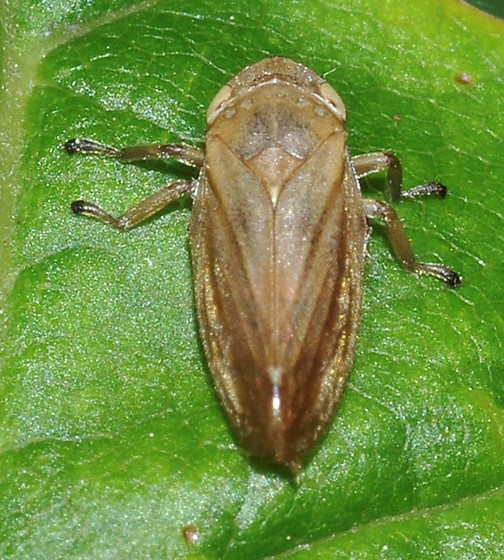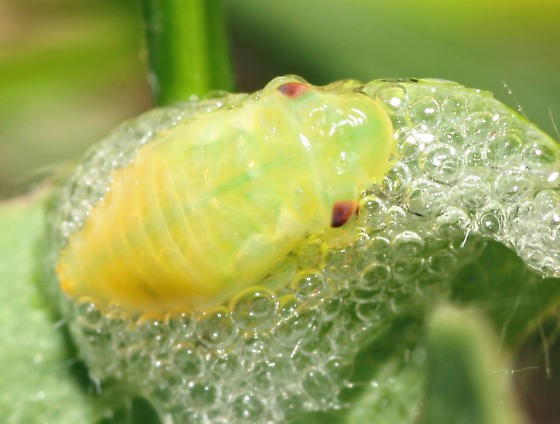Douglas G. Pfeiffer, Dept. of Entomology, Virginia Tech

Meadow spittlebug is an insect that most people are familiar with, even those not involved with berry production. The masses of white, frothy spittle-like material are commonly seen on meadow grasses and other plants. If you pull apart the froth, a green nymph is usually found feeding within.
Spittlebugs or froghoppers, are in the family Cercopidae (sometimes considered Aphrophoridae), are superficially similar to the leafhopper family Cicadellidae, to which they are related. However, the adults are more squat in appearance, giving rise to the name froghopper. They are further differentiated by the presence of course spurs on the hind tibia, compared with smaller spines of leafhoppers.
Adults are about a quarter inch long (5-7 mm), and are highly variable in color, ranging from yellowish brown to almost black. Adults are active jumpers, aided by backward-pointing spines on the legs; these provide traction by digging into plant surface tissue (Goetzke et al. 2019). These spines are hardened by incorporation of zinc into the cuticle, and leave tiny wounds in the leaf surface after jumping.
The life history was nicely summarized by Weaver and King (1954). Winter is spent in the egg stage; eggs hatch in April at Ohio latitudes, earlier farther south. There are five nymphal instars or developmental stages. Five to eight weeks are needed for nymphal development. Lower developmental threshold of 2.8° C (37° F) (Zajac et al. 1989). All nymphal development occurs within spittle mass. The foam is produced shortly after feeding starts – structures near the anus mix air bubbles into the liquid waste. In addition to protection from desiccation, the foam is thought to give some protection against predators, but some predators have adapted to this. While all development occurs with a foam mass, the insect may move around and start new feeding sites. Adult females develop eggs in August, and will lay eggs until killed by frost. Adults mate during August and September. Lay eggs low on plant (usually lower 4 inches), allowing them to use stubble. Females glue eggs into place at cracks and grooves near plant leaf sheathes. There are about 7 (1-30) eggs per mass. Eggs may be attacked by egg parasites, including mymarid and eulophid wasps.
Spittlebugs feed on xylem sap – the composition of spittle approximates that of this sap (Ponder et al. 2002), and has been used to help study xylem sap composition.
In most natural settings, spittlebugs are just a curiosity. But spittlebugs can rise to economic concern in strawberry. Spittle masses can be found on strawberry plants, where the nymphs feed. When numerous, the feeding nymphs can stunt plants and cause a reduction in yield and number of berries in the crop. Zajac and Wilson (1984) determined an action threshold of 2 nymphs per 0.1 m2. That level is well below normal field levels at times, (10-20/0.12) in that study, so this insect bears watching, especially if there were large numbers of adults in the previous fall.
There is another potential impact of meadow spittlebug. While the most important vectors of Xylella fastidiosa, the agent causing Pierce’s disease in grape, are sharpshooters (xylem-feeding leafhoppers), meadow spittlebug can also serve in this role. Spittlebugs are considered to be key vectors in Europe, where it has been associated with a decline of olive trees in Italy (Moussa et al. 2016, Bodino et al. 2021).
Because control recommendations may vary from state to state, consult local recommendations for populations of meadow spittlebugs that warrant control.

References
Bodino, N., V. Cavalieri, C. Dongiovanni, A. Simonetto, M. A. Saladini, E. Plazio, G. Gilioli, G. Molinatto, M. Saponari, and D. Bosco. 2021. Dispersal of Philaenus spumarius (Hemiptera: Aphrophoridae), a vector of Xylella fastidiosa, in olive grove and meadow agroecosystems. Environ. Entomol. 50: 267–279.
Cornara, D., A. Sicard, A. R. Zeilinger, F. Porcelli, A. H. Purcell, and R. P. P. Almeida. 2016. Transmission of Xylella fastidiosa to grapevine by the meadow spittlebug. Phytopathology 106.
Cornara, D., M. Marra, M. Morente, E. Garzo, A. Moreno, M. Saponari, and A. Fereres. 2020. Feeding behavior in relation to spittlebug transmission of Xylella fastidiosa. J. Pest Sci. 93: 1197–1213.
Goetzke, H. H., J. G. Pattrick, and W. Federle. 2019 Froghoppers jump from smooth plant surfaces by piercing them with sharp spines. PNAS 116: 3012-3017
Moussa, I. E. B., V. Mazzoni, F. Valentini, T. Yaseen, D. Lorusso, S. Speranza, M. Digiaro, L. Varvaro, R. Krugner, and A. M. D’Onghia. 2016. Seasonal fluctuations of sap-feeding insect species infected by Xylella fastidiosa in Apulian olive groves of southern Italy. J. Econ. Entomol. 109: 1512-1518.
Ponder, K. L., R. J. Watson, M. Malone, and J. Pritchard. 2002. Mineral content of excreta from the spittlebug Philaenus spumarius closely matches that of xylem sap. New Phytol. 153: 237-241.
Weaver, C. R., and D. R. King. 1954. Meadow spittlebug. Ohio Agric. Exp. Stn. Res. Bull. 741. 99 p.
Zajac, M. A., and M. C. Wilson. 1984. The effects of nymphal feeding by the meadow spittlebug, Philaenus spumarius (L.) on strawberry yield and quality. Crop Protect. 3: 167-175.
Zajac, M. A., F. R. Hall, and M. C. Wilson. 1989. Heat unit model for the development of meadow spittlebug (Homoptera: Cercopidae) on strawberry. Environ. Entomol. 18: 347-350.